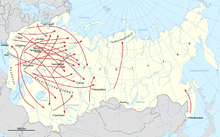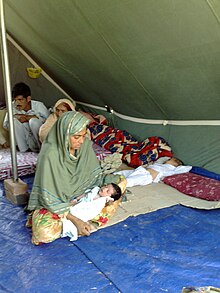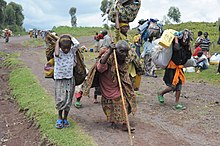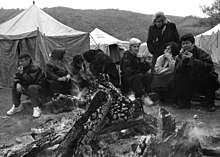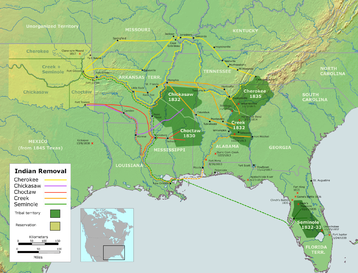Deportees to Siberia by Kazimierz Alchimowicz (1894), National Museum in Warsaw, illustrating the torment of Polish Siberian deportees, patriots from the Russian zone of partitioned Poland in the period following the collapse of the January Uprising.
General deportation currents of the dekulakization 1930–1931
The Amam refugee camp is named after its first native is born in 2009. Its name, Amam, means peace
Forced displacement or forced immigration is the coerced movement of a person or people away from their home or home region and it often connotes violent coercion. Someone who has experienced forced displacement is a "forced immigrant", a "displaced person" (DP), rarely also a "displacee", or if it is within the same country, an internally displaced person (IDP). In some cases the forced immigrant can also become a refugee, as that term has a specific legal definition. A specific form of forced displacement is population transfer, which is a coherent policy to move unwanted groups, for example, as an attempt at ethnic cleansing. Another form is deportation.
Forced displacement has accompanied persecution, as well as war,
throughout human history but has only become a topic of serious study
and discussion relatively recently. This increased attention is the
result of greater ease of travel, allowing displaced people to flee to
nations far removed from their homes, the creation of an international
legal structure of human rights, and the realizations that the
destabilizing effects of forced immigration, especially in parts of Africa, the Middle East, south and central Asia, ripple out well beyond the immediate region.
Definition
The concept of forced displacement envelopes demographic movements like flight, evacuation, displacement, and resettlement. The International Organization for Migration
defines a forced migrant as any person who migrates to "escape
persecution, conflict, repression, natural and human-made disasters,
ecological degradation, or other situations that endanger their lives,
freedom or livelihood".
The International Association for the Study of Forced Migration
(IASFM) defines it as "the movements of refugees and internally
displaced people (those displaced by conflicts) as well as people
displaced by natural or environmental disasters, chemical or nuclear
disasters, famine, or development projects."
According to Alden Speare, "in the strictest sense migration can
be considered to be involuntary only when a person is physically
transported from a country and has no opportunity to escape from those
transporting him." Movement under threat, even the immediate threat to
life, contains a voluntary element, as long as there is an option to
escape to another part of the country, go into hiding or to remain and
hope to avoid persecution."
However this thought has been questioned, especially by Marxians, who
argue that in most cases migrants have little or no choice.
Causes
Causes for forced displacement can include:
- Natural disaster: Occurrence of a disaster – such as floods, tsunamis, landslides, earthquakes or volcanoes – leads to temporary or permanent displacement of population from that area. In such a scenario, migration becomes more of a survival strategy, as natural disasters often cause the loss of money, homes, and jobs. For example, Hurricane Katrina resulted in displacement of almost the entire population of New Orleans, leaving the community and government with several economic and social challenges.
- Environmental problems: The term environmental refugee has been in use recently representing people who are forced to leave their traditional habitat because of environmental factors which negatively impact their livelihood, or even environmental disruption i.e. biological, physical or chemical change in ecosystem. Migration can also occur as a result of slow-onset climate change, such as desertification or sea-level rise, of deforestation or land degradation.
- Man-made disasters: Examples are industrial accidents and especially accidents that involve chemicals or radioactivity, such as in Chernobyl, Bhopal or Fukushima.
- War, civil war, political repression or religious conflicts: Some migrants are impelled to cross national borders by war or persecution, due to political, social, ethnic, religious reasons. These immigrants may be considered refugees if they apply for asylum in the receiving country.
- Development-induced displacement: Such displacement or population transfer is the forcing of communities and individuals out of their homes, often also their homelands, for the purposes of economic development. It has been historically associated with the construction of dams for hydroelectric power and irrigation purposes but also appears due to many other activities, such as mining and transport (roads, ports, airports). The best-known recent example of such development-induced displacement may be that resulting from the construction of the Three Gorges Dam in China. This type of forced migration disproportionately affects low income earners and ethnic minorities. According to estimates, between 90 and 100 million people were forced to leave their homes due to development projects in the 1990s.
- Human trafficking and human smuggling: Migrants displaced through deception or coercion with purpose of their exploitation fall under this category. The data on such forced migration are limited since the activities involved are clandestine in nature. While migration of this nature is well covered for male migrants (working in agriculture, construction etc.), same cannot be said for their female counterparts as the market situation for them might be unscrupulous (sex work or domestic service). The International Labour Organization considers trafficking an offence against labor protection and denies them the opportunity of utilizing their resources for their country. ILO’s Multilateral Framework includes principle no. 11 that recommends, "Governments should formulate and implement, in consultation with the social partners, measures to prevent abusive practices, migrant smuggling and people trafficking; they should also work towards preventing irregular labor migration.
- Slavery: History's greatest forced migration was the Middle Passage of the Atlantic slave trade during the 15th through the 19th centuries. Of the 20 million Africans captured for the trade, half died in their forced march to the African coast, and another ten to twenty percent died on slave ships carrying them from Africa to the Americas.
- Ethnic cleansing: The systematic forced removal of ethnic or religious groups from a given territory by a more powerful ethnic group, with the intent of making it ethnically homogeneous. For example, during counter-Reformation the Catholics removed of Protestants during the 16th through 19th centuries in Europe (e.g. Salzburg Protestants).
Conditions
In
the majority of cases forced migration across borders takes place
without the required documentation. It may even involve human smugglers
and traffickers. Displaced persons are often forced to place their lives
at risk, are obliged to travel in inhumane conditions and may be
exposed to exploitation and abuse. The states where they seek protection
may regard them as a threat to their security.
Displaced persons face risks of becoming poorer than before
displacement, of being financially vulnerable, and socially
disintegrated.
The impacts of forced displacement vary according to the displaced
person's ability to recover from the shock of displacement. Individuals
are displaced by conflict and then depleted of their assets upon arrival
to a new country where they can also face cultural, social, and
economic discontinuity.
Responses to Forced Displacement
Responses
for forcibly displaced persons vary across multiple levels. Response at
the global stage is done by participating international agencies (e.g.
the UNHCR)
and by members of international conventions. The rights and protections
of the different categories of forcibly displaced persons have been
addressed by, e.g., the 1951 Refugee Convention, the 1967 Protocol, the Kampala Convention, or the 1998 Guiding Principles. These protections, however, are not always respected or met.
World organizations such as the United Nations and the World
Bank, as well as individual countries have also directly responded to
the challenges faced by displaced people by providing humanitarian
assistance or forcibly intervening in the country of conflict. The
absence of neutrality and limited resources has affected the
capabilities of international humanitarian action to mitigate the forces
causing mass displacement. These broad forms of assistance can also not fully address the multidimensional needs of displaced persons.
Sources of action can occur at more local levels such as the
individual's place of relocation. Lived in experiences of displaced
persons will vary according to the state and local policies of their
country of relocation. Policies reflecting national exclusion of
displaced persons may be undone by inclusive urban policies. Sanctuary
cities are an example of spaces that regulate their cooperation or
participation with immigration law enforcement.
The practice of urban membership upon residence allows displaced
persons to have access to city services and benefits, regardless of
their legal status.
Sanctuary cities have been able to provide migrants with greater
mobility and participation in activities limiting the collection of
personal information, issuing identification cards to all residents, and
providing access to crucial services such as health care.
Access to these services can ease the hardships of displaced people by
allowing them to healthily adjust to life after displacement.
Overview and distinctions between the terms
- The term 'Refugee Studies' denotes an academic discipline or field of study which covers the study of refugees, often their experiences in seeking refuge. There are several categories of individuals who are included in this study, with labels that include: 'Refugee’; ‘expellees’; ‘exile’; ‘displaced person’; ‘internally displaced person (IDP)’; ‘economic refugees’; ‘humanitarian refugee’; ‘stateless person’; ‘tsunami refugee’; ‘development refugee’; ‘environmental refugee’; ‘government assisted refugee (GAR)’ etc.
- The term displaced person (DP) was first widely used during World War II and the resulting refugee outflows from Eastern Europe, when it was used to specifically refer to one removed from their native country as a refugee, prisoner or a slave laborer. Most of the victims of war, political refugees and DPs of the immediate post-Second World War period were Ukrainians, Poles, other Slavs, as well as citizens of the Baltic states – Lithuanians, Latvians, and Estonians, who refused to return to Soviet-dominated eastern Europe. A.J. Jaffe claimed that the term was originally coined by Eugene M. Kulischer. The meaning has significantly broadened in the past half-century.
- If the displaced person has crossed an international border and falls under one of the relevant international legal instruments, they may become a refugee. The term "refugee" is also commonly used as a synonym for displaced person, causing confusion between the general descriptive class of anyone who has left their home and the subgroup of legally defined refugees who enjoy specified international legal protection. However, forced migrants may not apply for asylum in the country they fled to, so they may not be classed as asylum seekers or – if application would be successful – refugees. The terms refugee and asylum seeker always have a legal framework or system as context. If forced migrants do not access this legal system or it does not exist in the country they have fled to, they cannot be categorised as such.
- Forced migrants are always either IDPs or displaced people, as both of these terms do not require a legal framework and the fact that they left their homes is sufficient. The distinction between the terms displaced person and forced migrant is minor, however, the term displaced person has an important historic context (e.g. World War II).
- A displaced person who crosses an international border without permission from the country they are entering, and without applying for asylum, may be considered an illegal immigrant.
- A displaced person who left their home because of political persecution or violence, but did not cross an international border, is commonly considered to be the less well-defined category of internally displaced person (IDP), and is subject to more tenuous international protection. In 1998, the UN Commission of Human Rights published the Guiding Principles which defined internally displaced people as "persons or groups of persons who have been forced or obliged to flee or leave their homes or places of habitual residence in particular as a result of or in order to avoid the effects of armed conflict, situations of generalized violence, violations of human rights, or natural or human-made disasters and who have not crossed an internationally recognized State border." Bogumil Terminski distinguishes two general categories of internal displacement: displacement of risk (mostly conflict-induced displacement, deportations and disaster-induced displacement) and displacement of adaptation (associated with voluntary resettlement, development-induced displacement and environmentally-induced displacement).
- If the displaced person was forced out their home because of economically driven projects like that of the Three Gorges Dam in China and various Indian dams, it is called development-induced displacement. People are also often displaced due to natural or man-made disasters. Displacement can also occur as a result of slow-onset climate change, such as desertification or sea-level rise. A person who is displaced due to environmental factors which negatively impact their livelihood is generally known as an environmental migrant. Such displacement can be cross-border in nature but is frequently internal. No specific international legal instrument applies to such individuals. Foreign nations often offer disaster relief to mitigate the effects of such disaster displacement.
- Displaced person generally refers to one who is forced to migrate for reasons other than economic conditions, such as war or persecution. A migrant who fled because of economic hardship is an economic migrant.
Criminal prosecution
Forced
displacement has been subjected to several trials before local and
international courts. One of the requirements that need to be met for an
offence as a war crime is that the victim is a "protected person" under international humanitarian law.
The expression "protected person" originally referred only to the
categories of individuals explicitly protected under one of the four Geneva Conventions of 1949, but was later accepted as defining a civilian or police force who do not participate directly in a conflict. Following the end of World War II, the Krupp trial
was held with a specific charge to the forced displacement of civilian
populations for the purpose of forced labour. The US Military Tribunal
concluded that "
[t]here is no international law that permits the deportation or the use
of civilians against their will for other than on reasonable
requisitions for the need of the army, either within the area of the
army or after deportation to rear areas or to the homeland of the
occupying power". At the Nuremberg trials, Hans Frank, chief jurist in occupied Poland, was found guilty, among others for forced displacement of the civilian population.
In Article 49, the Fourth Geneva Convention, adopted on 12 August 1949, specifically forbids forced displacement:
| “ | Individual or mass forcible transfers, as well as deportations of protected people from occupied territory to the territory of the Occupying Power or to that of any other country, occupied or not, are prohibited, regardless of their motive. | ” |
The Rome Statute of the International Criminal Court defines forced displacement as a crime within the jurisdiction of the court:
| “ | "Deportation or forcible transfer of population" means forced displacement of the people concerned by expulsion or other coercive acts from the area in which they are lawfully present, without grounds permitted under international law. | ” |
Several people were tried and convicted by the ICTY for connection to forced displacement during the Yugoslav Wars in the 1990s. On 11 April 2018, the Appeals Chamber sentenced Vojislav Šešelj 10 years in prison under Counts 1, 10, and 11 of the indictment for instigating deportation, persecution (forcible displacement), and other inhumane acts (forcible transfer) as crimes against humanity due to his speech in Hrtkovci on 6 May 1992, in which he called for the expulsion of Croats from Vojvodina. Other convictions for forced displacement included ex-Bosnian Serb politician Momčilo Krajišnik, ex-Croatian Serb leader Milan Martić, former Bosnian Croat paramilitary commander Mladen Naletilić, and Bosnian Serb politician Radoslav Brđanin.

